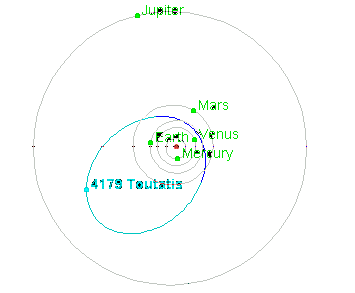4179 Toutatis
![]()
|
Discoverer |
C. Pollas - 1989 |
|
Diameter (km) |
4.6 x 2.4 x 1.9 |
|
Mass (kg) |
5*10^13 |
|
Rotation period (hrs) |
Chaotic |
|
Orbital period (yrs) |
3.98 |
|
Semimajor axis (AU) |
2.51064 |
|
Orbital eccentricity |
0.63439 |
|
Orbital Inclination (deg) |
0.46957 |
|
Albedo |
0.13 |
|
Type |
S |

|
Named after the Gaulish god, protector of the tribe. This totemic deity is well known because of the cartoon series "Les aventures d'Asterix" by Uderzo and Goscinny. This tells the stories of two almost fearless heroes living in the late village under siege in Roman-occupied Gaul in 50 B.C., and whose only fear is that the sky may fall onto their heads one day. Since this object is the Apollo object with the smallest inclination known, it is a good candidate to fall on our heads one of these days... Most oft the asteroids, and all the planets, spin about a single axis but has extraordinarily complex rotation. Toutatis doesn't have anything that could be called a 'day.' Its rotation is the result of two different types of motion with periods of 5.4 and 7.3 Earth days, that combine in such a way that Toutatis's orientation with respect to the solar system never repeats. One consequence of this strange rotation is that Toutatis does not have a fixed north pole like the Earth. Instead, its north pole wanders along a curve on the asteroid about every 5.4 days. The rotations of hundreds of asteroids have been studied with optical telescopes. The vast majority of them appear to be in simple rotation with a fixed pole and periods typically between one hour and one day, the scientists said even though the violent collisions these objects are thought to have experienced would mean that every one of them, at some time in the past, should have been tumbling like Toutatis. Internal friction has caused asteroids to change into simple rotational patterns in relatively brief amounts of time. However, Toutatis rotates so slowly that this process would take much longer than the age of the solar system. This means that the rotation of Toutatis is a remarkable, well-preserved relic of the collision-related evolution of an asteroid. The scientists' computer model reveals Toutatis to have dimensions of 4.6 by 2.4 by 1.9 kilometers. Numerous surface features, including a pair of half-mile-wide craters, side by side, and a series of three prominent ridges are presumed to result from a complex history of impacts. Radar was used to obtain images in 1992, when Toutatis passed to within 3.6 million kilometers from the Earth. Its eccentric, four-year orbit extends from just inside the Earth's orbit to the main asteroid belt between Mars and Jupiter. The plane of Toutatis's orbit is closer to the plane of the Earth's orbit than any known Earth-orbit-crossing asteroid. On September 29, 2004, Toutatis will pass by Earth at a range of four
times the distance between the Earth and the Moon, the closest approach
of any known asteroid
or cometbetween now and 2027. One consequence of the asteroid's frequent
close approaches to Earth is that its trajectory more than several centuries
from now cannot be predicted accurately. In fact, of all the Earth-crossing
asteroids,
the orbit of Toutatis is thought to be one of the most chaotic. |
|
Images of Toutatis |
|
(© Copyright 1995 by the AAAS) |
|||
|
(© Copyright 1995 by the AAAS) |
|||
|
(Credit JPL/NASA) |
|||
|
|
|||
|
It may have been sculpted by impacts into a single, coherent body, or Toutatis might actually consist of two separate objects that came together in a gentle collision. (Credit Scott Hudson, Washington State University) |
|||
|
This image shows the shape and non-principal-axis spin state of asteroid 4179 Toutatis rendered at a particular instant. The red, green, and blue axes are the principal axes of inertia; the magenta axis is the angular momentum vector; the yellow axis is the spin vector. If a flashlamp was attached to the short axis of inertia (the red axis) and flashed it every 15 minutes for a month, it would trace out the intricate path indicated by the small spheres stacked end-to-end. |
|||
|
If this process was continued forever the path would never repeat. Toutatis's spin state differs radically from those of the vast majority of solar system bodies that have been studied. (© Copyright 1995 by the AAAS) |
|||
|
3D view of Toutatis (credit Scott Hudson) |
|||
![]()
Last updated: March 15, 2002.